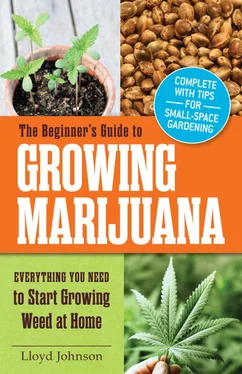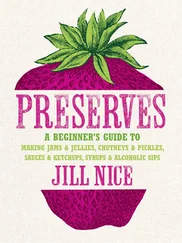Watering ten large cannabis plants in twenty-gallon containers can take a lot longer than you might think. An egg timer is a useful tool for watering; you can start the water going and come back to check at fifteen-minute intervals. The container should fill and drain down three times to ensure that the plant is watered thoroughly. Just damping the top surface of the soil may look good, but the lower part of the container soil will be dry as a bone, and leave your plants unhappy and thirsty.
Depending on weather conditions (extra hot, or windy, or rainy and cool), you will have to vary your watering schedule. Stick a finger into the soil near the plants’ roots. Is the soil damp from dew and extremely dry underneath? You need to know before the plants show stress.
During the phase of vegetative growth, it is fine for the outdoor grower to spray the plants’ leaves off after watering in the evening. This will knock off most unwanted insects and refresh the plants after a long, hot day. Do not overhead water cannabis as a general practice: The plants do not like or require it, and you risk burning the leaves if the sun is high and hot.
Keep It Simple
A moisture meter is an invaluable aid in checking how much water your plants need. These are readily available at your local garden supply, starting at under $5.
Container gardening of cannabis is a fun and relatively easy way to start out as a grower, and most indoor growers have to use containers. It is a good way to protect plants from bad soils and burrowing animals, and it is extremely productive if done correctly.
CHAPTER 7
Cannabis Indoors
Although some people in urban areas still grow a few cannabis plants in their vegetable gardens, generally the urban cannabis farmer is forced to grow inside. In the medical-use states, this is not because of law enforcement but because of thieves. Prohibition continues to make cannabis extremely expensive for those who must purchase it on the black market.
Indoor growing does have some advantages, especially if the grower lives in a geographic area that has very short growing seasons. Indoor growers are less tied to their crops; during the season, an outdoor grower must always be on site or risk losing his cannabis. Indoor growers can check the grow room in the morning and drive off to work. As long as they have been discreet about their growing activities, there is usually very little to alert thieves that valuable cannabis is inside.
Indoor growers have far less worry about accidental pollination of their prize female plants; unless they place a male in the grow room or carry pollen into the plants on their clothes, they are guaranteed pure sinsemilla, or seedless, female plants. Outdoor growers, of course, must worry about wind-borne pollen that may have traveled silently and invisibly to the grow site. Although useable, seeded cannabis is not considered of high value and is usually harsher to smoke.
The indoor grower’s crop is almost never bothered by wildlife bigger than a spider mite (see Chapter 9: Dealing with Mites). Deer, roving livestock, burrowing rodents, or wood rats cannot access your prized plants.
Another aspect of indoor growing is the ability to always have a crop in cycle. Once the outdoor season is over, the outdoor grower has completed the entire year’s harvest. An indoor grower can produce a crop every ten to twelve weeks. Crop failures or theft are still annoying and expensive, but the indoor grower has the option to start again immediately.
One of the biggest problems of growing cannabis indoors is the expense. The grow room or rooms must be constructed properly. Most indoor growers have a vegetative room and a flowering room so that they can keep a crop in cycle at all times. The equipment for lights, ventilation, humidity, and odor-control requires a large initial outlay. The power bills to keep the artificial environment running are prohibitive. Having a productive indoor grow is a costly investment.
Another thing to consider is space. You will lose personal space in your home after you designate an area for grow rooms, or face the expense of building and maintaining a special building for your growing activities. If you have a large basement in your house, or unused outbuildings, this is less of a problem.
The other huge problem for indoor growers is keeping the grow rooms clean and pest free; spider mites are the number-one enemy of the indoor cannabis grow. The artificial environment tends to preclude assistance from nature, a very large and powerful helper indeed.
Another downside to having your grow actually within your home is that your home is where you live. If home invasion thieves come in for your cannabis, you are in there with it. Cannabis thieves can be armed and willing to kill for the financial value of your crop. The outdoor grower may lose his crop, but he can choose whether or not to confront thieves. In medical cannabis states, law enforcement is mandated to respond and protect the grower; an outdoor grower can monitor a situation from inside his home and call the police for help.
What if you are not a licensed medical grower? If law enforcement gets a warrant to come in your home, you, your family, and your pets may be in great danger not only because of possible arrest and incarceration, but also of being in the line of fire. This danger, plus the odds that your home will be trashed, greatly increases when the police perform a raid on an indoor grow.
The final disadvantage of an indoor grow is that it is far less productive than an outdoor grow for a great deal more use of diminishing world resources. Even if the financial expense is not an issue, the indoor cannabis grower must reflect and consider the immense use of fossil fuels to produce a relatively small amount of cannabis.
The basic and essential materials you will need to grow cannabis indoors are as follows:
• A prepared space to grow in, or grow room
• Lights
• Fans
• Odor-control system, usually carbon filtered
• Air intake and exhaust system
• Thermometer
• Hygrometer
• Pots or containers
• Soil or soilless growing medium
• Soil amendments
• Cannabis cuttings, seeds, clones, or seedlings
Most indoor growers start out with a single grow room; this makes sense until you decide if indoor growing is for you. The high-production approach uses two grow rooms. One is for the vegetative stage of the cannabis life cycle, and the other is a flowering room. Using two rooms lets the indoor grower continually cycle and harvest cannabis. Using one room mimics the outdoor cycle on an immensely speeded-up time frame.
Make certain the grow area has access to electrical outlets in good working condition. You will be placing a lot of power load on the electrical system, and many an indoor grow has gone up in flames when the electrical setup was done casually or too cheaply. Remember, this is usually also where you live, so you could lose far more than just your cannabis.
Keep It Simple
Ideally, your grow room(s) will be located in a basement. A basement is not in the general living area of a home and is less likely to have visitors wonder about what you do there, and the temperature in a basement is usually very stable. You can also block light loss more easily, and it is far more difficult for thieves to gain access.
Venting
The space should be vented, as big lights generate a lot of heat. Separate exhaust and incoming air vents are best—one at the top of the room to exhaust air into the attic or out the roof, and one to bring in air from an outside wall or crawlspace.
Читать дальше












